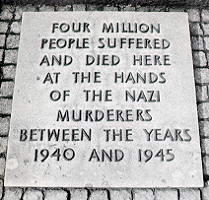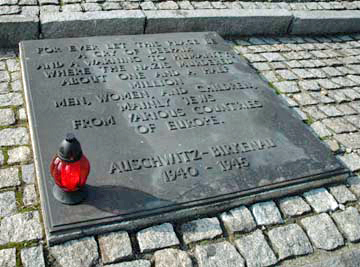Dachau Liberated: The Official Report, a book written by the American liberators of Dachau, was published in 2000. Chapter 5 of the report was entitled “Rudolf Hoess’ Mistress.”
Rudolf Hoess was the infamous Commandant of Auschwitz-Birkenau. His so-called mistress, a woman named Eleanor Hodys, was a prisoner in Block 11 at the main Auschwitz camp for nine months, but after she became pregnant, allegedly by Hoess, and had an abortion, she was released and transferred to Munich. She was then sent to Dachau, ten miles from Munich, where she was liberated on April 29, 1945. To protect her identity, The Official Report only gave her initials: E.H.
Eleanor Hodys told the American liberators that she had been a prisoner in Block 11, waiting to be executed at the Black Wall. She said that Commandant Hoess entered her cell on the night of December 16, 1942.

Block 11 at Auschwitz; black wall on the left
The Official Report mentioned that E.H. had been working in the Commandant’s house in May 1942 when she was first approached by Hoess, who kissed her. She was frightened and locked herself in the toilet. She reported herself sick and did not go back to his house anymore.
Then one day, an SS officer came to tell E.H. that she should bathe, have her hair dressed, put on her best clothes, and call on the Commandant’s wife on Sundays. After awhile, the Commandant’s wife told her that she need not come to call on Sundays any more because the Commandant was sick and she was staying with him in another town. Two or three days later, E.H. was told that she “had committed some infraction in the Commandant’s house.”

The house where Rudolf Hoess lived at Auschwitz
E.H. claimed that she wrote letters to the Commandant and his wife and the cook at the Commandant’s house in which she “explained the facts and asked them to take no account of rumors and to do something for me.”
E.H. said that she received no answer, but the next day after her letters had been received, she was sent to Block 11, where prisoners were customarily held to await execution. This was on October 16, 1942, the day that she was scheduled to begin work in a camp hospital and it had been hinted that she might be released to work in a hospital on the Eastern Front.
So what really happened? Did Commandant Hoess really try to seduce E.H. or did she do something wrong while she was visiting at the Commandant’s house? Why did she write a letter to the cook who worked in the Hoess house?
Heinrich Himmler had urged his SS officers to have at least four children and to take a mistress if necessary. Himmler himself took a young mistress when his wife became too old have any more children.
From the account given to the Americans by Eleanor Hodys, it seems that the Commandant’s wife was O.K. with her husband trying to woo a prisoner by inviting her to visit his house on Sundays. But then something happened and his wife told E.H. not to come on Sundays any more.
Was rejection of the advances of the Commandant enough reason to condemn a woman to be executed?
In her account given to the Americans, E.H. said that she was “taken to execution.” She described how an SS man named Gehring had come to her cell (Cell #26) and had instructed her to get ready because she was going to be shot. But suddenly, two SS men named Maximilian Grabner and Hans Aumeier came into the courtyard to “meet the prisoners” who were walking to the Black Wall to be shot that day. E.H. said that these two SS men were shocked to see her among the prisoners to be executed and “made everyone go back” to their cells in Block 11. Grabner called her an hour later and told her that “the whole thing was a joke.”
He “called” her? Did she have a phone in her cell in Block 11? The Nazis were some real pranksters, but did they really execute prisoners as a joke?

E.H. was in Cell #26 right next to Cell #27

Maximilian Grabner, head of the Gestapo department at Auschwitz
E.H.’s description of the way that Hoess allegedly seduced her in her cell in Block 11 borders on rape. Hoess was a nice looking man before he was tortured by the British. He could have had any woman he wanted, and apparently his wife would have approved, so why did he relentlessly harass E.H. until she finally consented to have sex with him?

Commandant Rudolf Hoess is the man in the center
E.H. said that she was moved to Cell #6 “that one could open and shut from the inside.” This was apparently for the convenience of the Commandant, so that she could let him in and out of her cell. What kind of a prison has cells that the prisoners can go in and out of whenever they please?
This quote, from the words of E.H., is in Chapter 5 in Dachau Liberated: The Official Report:
Some days later, he (the Commandant) came again during the night. He asked then if he should go away. I said “no.” He asked me what I had to say. I told him he knew what I had to say. Then he came to me in the bed, and we had sexual intercourse. […] All in all we had four or five nights of sexual intercourse.
Photos of Hoess show that he was a well-groomed, fastidious man. He doesn’t look like a man who would practically rape a woman in a dirty prison cell.
E.H. said that she asked the Commandant what would happen to her if it were discovered that she was having sex with him. He told her that she should deny it. Then he advised her to say that she was having sex with a prisoner named Fichinger. Nothing would happen to her if she were having an affair with a fellow prisoner. Then E.H. claims that the Commandant “took a sheet of paper out of his notebook” and ordered her to write out a “declaration” that she “had an acquaintance” with Fichtinger. Did the Commandant of Auschwitz really carry a notebook with him when he went, in the middle of the night, into a prison cell to have sex with a prisoner?
Later on, in her account, E.H. referred to Fichtinger as her finance, and she mentioned that he advised her under all circumstances not to mention the Commandant’s name. Was E.H. really having an affair with the Commandant, or did she get pregnant by Fichinger and then blame it all on the Commandant?
Was E.H. crazy? Just in case someone might say that she was crazy, E.H. took care of that little detail in her account. She said, “I was careful enough to put myself under psychiatric care.” A Polish camp doctor had treated her in Auschwitz and a “certificate” from him was in the possession of Fichtinger, according to her account.
The important thing about Chapter 5 is that all of the events described by E.H. happened at Auschwitz, not at Dachau. She mentioned the “standing cells” in Block 11 at Auschwitz and claimed that she had once been put into a standing cell herself — for NINE WEEKS. How could anyone survive for nine weeks in a standing cell like the ones that have been reconstructed at Auschwitz?

Reconstructed standing cell at Auschwitz
E.H. claimed that she was not told why she was put into a standing cell. This punishment was usually given to prisoners who had committed a serious crime, such as sabotage.
The Dachau Museum claims that there were “standing cells” at Dachau, although the Commandant and other staff members at Dachau denied this. The standing cells at Dachau were allegedly torn down by the Americans. Or did the Americans learn about standing cells from E.H. and decide to include them in the Dachau atrocities? It seems strange to me that the Americans would destroy evidence at Dachau.
Hans Aumeier, the SS man mentioned by E.H. in her story of almost being executed as a joke, was originally one of the prisoners that was scheduled to be prosecuted, at Dachau, by the American Military Tribunal, but he was cut from the list and sent to Poland instead for trial. Was he originally included in the AMT proceedings because E.H. had named him?
E.H. also mentioned the infamous hanging punishment in her account. She said that a prisoner named Bruno Graf died “after he had been hung by the arms for five hours in the sun.” One of the atrocities that allegedly happened at Dachau was that prisoners were hung by their arms in the shower room. Did the American liberators learn about the hanging punishment from E.H. or did this really happen at Dachau?
The whole story of E.H., as told in Chapter 5 of the Dachau report, seems suspicious to me. Why did the Americans seek her out as one of the 20 prisoners that they questioned? Her imprisonment had been mainly at Auschwitz, not at Dachau.








